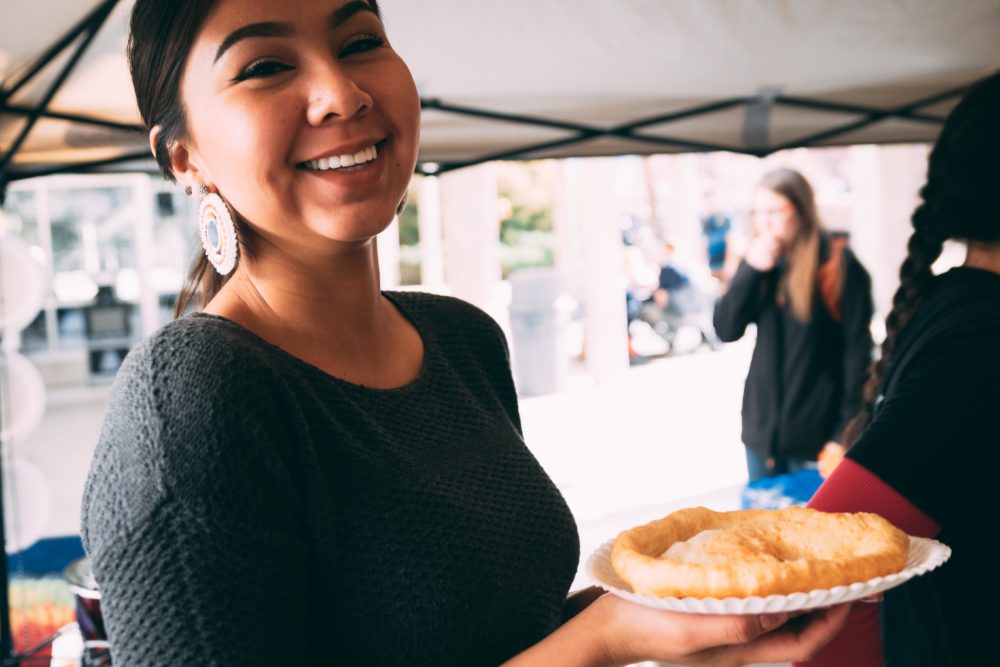Native American Student Council celebrating heritage through a month of thanksgiving
According to Alina Begay, the advisor for the Access & Diversity Center at Utah State University, the Navajo tribe is one of the 569 largest federally-recognized tribes in the United States.
There are federally-recognized tribes and state-recognized tribes. Federally-recognized tribes are recognized by the United States government as sovereign nations, or separate countries, within the United States.
Each tribe has their own government and elected leaders, including a president, vice president, judicial system and police department. Each tribe is different.
State-recognized tribes are only recognized by the state and they don’t receive the same benefits or funding that federally-recognized tribes get.
Each tribe is a thriving community and its culture is still strong today.
“We are still here and we are still strong,” said Denishia Tsosie, the president of the Native American Student Council (NASC), as well as a part of the Navajo tribe.
Tsosie has been working hard to make people aware of cultural appropriation, especially with Thanksgiving last month.
“Thanksgiving to me is all about being thankful for the land that we are living on and the families that are living with us today,” Tsosie said.
The secretary of NASC, Brycee Sells, mentioned how important it is to her and others to not call Native Americans “American Indians” or “Indian.”
“It goes back to when America was discovered and they labeled us as Indians because they thought they were in a different part of the country,” Sells said. “It brings me back to the genocide of my people.”
“I don’t call myself an Indian, I call myself a Navajo or Native American,” said Christopher Capitan, the treasurer of NASC.

Tyra Hardin, Vice President of the Native American Student Council Club delivers a fresh frybread to a student costumer around lunch time.
Capitan introduced himself with the four clans he identifies with. The first is Naakai Dine’e, which is the Mexican Peoples clan. The second is Ashiihi, the Salt Peoples clan. The third is Bitahnii, the Folded Arm Peoples clan. The fourth is Kaiyaa’aanii, the Towering House Peoples clan.
The first of the four clans is Capitan’s mother’s clan, the second is his father’s clan, the third is his maternal grandfather’s clan, and the fourth is his paternal grandfather’s clan.
The clan identification method started because there was as a tribe made up of many different types of people who got separated into different families and started making up their own clans, according to Sells.
“This shows where we come from and how we represent them,” Sells said. “It tells the history of our genetics.”
On Thanksgiving, Capitan says his family doesn’t eat turkey, they eat Navajo food: mutton stew, corn stew, blue corn mush and, of course, pumpkin pie.
“I do respect Thanksgiving Day, but I don’t celebrate it,” Capitan said.
To have mutton on Thanksgiving is a tradition for many Navajo families.
According to Sells, some people raise sheep and sell them for $150-200. Navajo families pick one out and take it home to butcher it for the mutton stew.
There is also a traditional blood stew. It is traditionally prepared by using the blood from the sheep, baking or grilling it with potatoes, celery, onions and many other vegetables so the blood hardens.
“A lot of people don’t like it, but I think it’s good,” Sells said.
Some, but not all, Navajo families cook the sheep head. According to Sells, you wrap sheep head in foil and bury it under the hot ash to cook it.
“There are actually some parts of the head that are pretty good, I think,” Sells said.
Capitan said he has always had a different view around Thanksgiving. He found it odd that in school they would roleplay as the Native Americans helping the pilgrims and would all sit down for a meal.
When he was younger he was told different stories about Thanksgiving from his grandfather.
“Basically the Anglo people coming into America and said, ‘You’re not a true American, you need to become true American by being a Christian and cut your hair and speak English,’” Capitan said. “He actually escaped that.”
Capitan’s father taught him the true meaning of giving thanks.
“One thing my dad taught me when I was a kid is that you shouldn’t just focus (thankfulness) all on one day, it’s every day,” Capitan said. “Every day I was taught to always be thankful.”
The theme of thankfulness was carried out throughout the month of November by NASC.

Navajo Taco Sale runned by the Native American Student Council Club of USU.
On Nov. 6, NASC hosted a bead-and-chill event where they made authentic Native American jewelry and watched a movie.
On Nov. 9, NASC hosted a Navajo taco sale, as they were most known for their fry bread, according to Tsosie.
On Nov. 25, Matika Wilbur came and spoke about of her most recent photography project. Wilbur is a Native American photographer from Washington.
“She is a public figure and role model to us, so it was really cool to have her here,” Tsosie said.
On Nov. 30, NASC hosted an Indigenous Thanksgiving Potluck, where they got together to eat their native food and enjoy each other’s company.
For those interested in learning more about their native culture, the NASC is hosting their biggest annual event, the Powwow, the week after spring break.
“You get to experience different Native American cultures when gathering, and different types of foods and vendors,” Tsosie said.
The Powwow is a two-day event that will run from March 16-17.
— cawolf9290@gmail.com
@warewolf74

